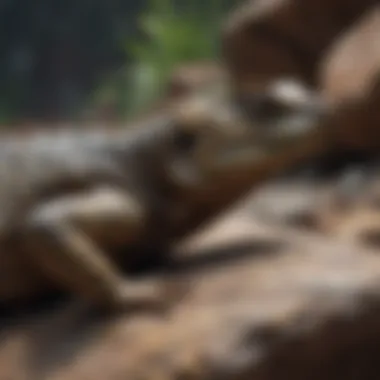Unveiling the Enigmatic Behavior of Large Reptiles Basking on Rocks


Animal Species Profile
Introduction to the Large Reptile Species
Reptiles are fascinating creatures, known for their enigmatic behavior and intriguing habits. Among these creatures, large reptiles basking on rocks stand out for their mysterious allure and unique adaptations. These reptiles captivate observers with their stoic presence and sun-soaking rituals, offering a glimpse into the ancient world of these cold-blooded beings.
Physical Characteristics and Appearance
Large reptiles that prefer to bask on rocks typically boast scales that aid in thermal regulation, enhancing their ability to absorb and retain heat from the sun. Their robust bodies, designed for efficient basking, are often adorned with striking patterns and colors to provide camouflage in their natural habitat.
Natural Habitat and Distribution
These majestic reptiles are commonly found in arid regions with ample sunlight, such as deserts, rocky outcrops, and savannas. By seeking out elevated rocky perches, they can optimize their exposure to the sun's rays for thermoregulation. From the deserts of Australia to the rocky landscapes of the American Southwest, large reptiles have adapted to thrive in diverse environments worldwide.
Behavior and Social Interactions
The behavior of large reptiles basking on rocks revolves around thermoregulation, basking to elevate their body temperature and maintain optimal metabolic function. While often perceived as solitary creatures during basking periods, they may exhibit communal behaviors in shared basking sites, showcasing intriguing social dynamics. Observing these reptiles in their natural habitat offers insights into their complex behaviors and interactions with their environment.
Introduction
In the vast tapestry of the natural world, there exists a mesmerizing sight that captures the essence of serenity and mystique – the image of large reptiles basking on rocks. This behavior, seemingly simple at first glance, harbors a wealth of complexity and significance waiting to be unravelled. As we embark on this captivating expedition into the enigmatic world of reptilian sunbathers, we will peel back the layers of their behavior, shedding light on their habits, ecological role, and evolutionary quirks.
Defining the Behavior
A pivotal aspect of understanding the behavior of large reptiles is to define the purpose and intricacies behind their sun-soaked rituals. Basking on rocks serves as more than a mere act of lounging; it is a strategic behavior deeply rooted in survival and thermoregulation. By immersing ourselves in the subtle nuances of this behavior, we gain insight into the physiological, behavioral, and ecological dimensions that shape the lives of these sun-worshipping creatures.
Evolutionary Perspectives
Large reptiles basking on rocks exhibit fascinating evolutionary perspectives that shed light on their adaptive behaviors throughout history. The importance of understanding these evolutionary perspectives lies in unraveling the intricate ways in which these reptiles have thrived in their environments over millennia. By delving into the specific elements of evolutionary adaptations, we can grasp the benefits that these reptiles have gained in terms of survival and reproduction through optimal thermal regulation and basking behaviors.
Adaptations for Thermal Regulation
The adaptations for thermal regulation seen in large reptiles basking on rocks are nothing short of remarkable. These reptiles have evolved specific physiological and behavioral mechanisms to effectively manage their body temperatures in varying environmental conditions. From physiological features such as coloration and scale patterns that aid in absorbing and retaining heat to behavioral traits like selecting the perfect basking spot and adjusting posture for optimal sun exposure, these adaptations are essential for their survival and overall health. Such intricate adaptations highlight the incredible resilience and adaptability of these reptiles in their natural habitats.


Ecological Significance
In delving into the mysteries of large reptiles basking on rocks, understanding their ecological significance unveils a deeper connection between these creatures and their environment. The behavior of basking plays a vital role in maintaining the optimal body temperature necessary for their physiological functions. By basking on rocks, these reptiles absorb heat from the sun, regulating their body temperature effectively. This not only aids in digestion but also impacts their overall metabolic processes, highlighting the intricacies of their eco-system adaptation.
Moreover, the basking behavior serves as a form of thermoregulation that influences the distribution and behavior of reptiles in their habitats. By strategically positioning themselves on rocks to soak up the sun's warmth, reptiles showcase a delicate balance between their survival strategies and environmental conditions. Observing these creatures basking provides valuable insights into the intricate web of ecological interactions that shape their existence.
The ecological significance of reptiles basking on rocks extends beyond individual behaviors, contributing to ecosystem dynamics and biodiversity maintenance. Studying this behavior allows researchers to grasp the interconnectedness between reptiles, rocks, and the surrounding environment. It sheds light on how these seemingly mundane actions reverberate across the ecosystem, emphasizing the profound effects of seemingly simple behaviors on larger ecological processes.
Regulating Body Temperature
The act of basking on rocks serves as a crucial mechanism for large reptiles to regulate their body temperature effectively. Rocks, with their ability to absorb and retain heat, provide an ideal platform for reptiles to achieve thermoregulation. By exposing themselves to the sun's rays while perched on rocks, these cold-blooded creatures elevate their body temperature to activate physiological functions.
This behavioral adaptation allows reptiles to attain the desired body temperature needed for metabolic activities and sustenance. By strategically selecting the optimal rocks for basking, these reptiles showcase a remarkable sense of thermoregulatory behavior. The intricate dance between sunlight, rocks, and reptiles highlights an evolutionary strategy honed over millennia to thrive in diverse habitats.
Through the process of basking on rocks, reptiles exhibit a sophisticated understanding of their environment's thermal dynamics. Their ability to navigate and utilize natural elements for thermal regulation underscores the finesse and adaptability of these creatures in response to environmental cues. Studying how reptiles regulate their body temperature through basking illuminates the intricate balance between environmental factors and biological imperatives in the natural world.
Species Variability
In understanding the enigmatic behavior of large reptiles basking on rocks, the concept of species variability plays a pivotal role. This aspect delves into the diverse nature of reptilian populations, each with unique adaptations and traits shaped by their evolution and environmental pressures. By studying species variability, researchers gain valuable insights into the genetic, physiological, and behavioral differences among various reptilian species, paving the way for a deeper understanding of their basking habits. This exploration sheds light on how different species interact with their surroundings, highlighting the significance of biodiversity in ecological systems. Through a nuanced analysis of species variability, this article aims to unravel the complex tapestry of reptilian life and its connections to their basking behavior.
Diverse Reptilian Groups
Within the realm of large reptiles basking on rocks, a myriad of diverse reptilian groups exist, each with its own distinct characteristics and behaviors. From the majestic monitors to the stealthy snakes, the reptilian kingdom boasts a plethora of captivating species that engage in basking rituals. These diverse groups exhibit a wide range of adaptations for thermoregulation and social interaction, reflecting the evolutionary paths they have traversed over millennia. By delving into the world of diverse reptilian groups, we gain a profound appreciation for the richness of reptilian biodiversity and the complexity of their behavior. Through detailed observations and comparative studies, we unravel the unique traits and ecological roles of different reptilian groups, enriching our understanding of their fascinating world.
Comparative Studies
Embarking on comparative studies within the realm of large reptiles basking on rocks allows researchers to uncover intriguing insights into the similarities and differences among various reptilian species. By examining behavioral patterns, physiological adaptations, and ecological roles across different reptilian groups, scientists can discern underlying patterns and evolutionary connections. Comparative studies shed light on how different reptilian species have adapted to diverse environments and challenges, offering a glimpse into the intricate web of life that governs their basking behaviors. This section delves into the nuances of comparative studies, emphasizing the importance of cross-species analysis in expanding our knowledge of reptilian behaviors and the overarching principles that govern their interactions with the environment.
Rock Selection and Orientation
Rock selection and orientation play a pivotal role in the behavior of large reptiles basking on rocks. The choice of rocks is not arbitrary but is influenced by various factors that impact the reptile's well-being. Different types of rocks offer distinct heating properties, affecting the reptile's thermoregulation process. Some rocks retain heat better, while others absorb heat quickly. The reptile's selection reflects its need for optimal heating conditions to regulate body temperature efficiently. Moreover, the orientation of the rock in relation to the sun is crucial. Maximizing exposure to sunlight ensures the reptile receives sufficient warmth for basking. This behavior reflects the reptile's intricate adaptation to its environment, showcasing a deeper connection to its surroundings.
Preferred Types of Rocks


Preferred types of rocks for basking are those with specific characteristics that enhance thermal regulation. Large, flat rocks are favored for their ability to absorb and retain heat, providing a stable and warm surface for the reptile. Additionally, rocks with rough textures allow the reptile to grip securely while basking. These rocks offer stability and safety, essential for the reptile's comfort and well-being during extended exposure to sunlight. Understanding the reptile's preference for certain rock types sheds light on its evolutionary adaptations and behavioral patterns, unveiling a unique aspect of its interaction with the environment.
Positioning for Optimal Heating
The positioning of the reptile on the chosen rock is critical for achieving optimal heating benefits. By aligning its body to the sun's rays, the reptile maximizes heat absorption, aiding in thermoregulation. Strategic positioning also allows the reptile to adjust its exposure to heat, preventing overheating or underheating. This behavior demonstrates the reptile's precise awareness of its own temperature needs, showcasing a sophisticated level of environmental adaptation. Observing how reptiles position themselves on rocks provides valuable insights into their behavioral strategies for maintaining thermal balance and highlights the intricacies of their basking rituals. The careful orchestration of rock selection and positioning accentuates the mystique and sophistication of large reptiles basking on rocks.
Behavioral Patterns
Large reptiles basking on rocks exhibit intricate behavioral patterns that offer insights into their daily lives and interactions. Understanding these patterns is crucial in unraveling the mysteries of their existence. By observing their behavior, researchers can discern essential information about their habits, preferences, and responses to environmental stimuli. Analyses of their behavioral repertoire provide valuable data for conservation efforts and ecological studies. From how they position themselves on rocks to their interactions with other species, each behavioral pattern serves a specific purpose in their survival and reproduction.
Daily Routines and Rhythms
The daily routines and rhythms of large reptiles while basking on rocks follow a structured pattern dictated by environmental conditions and internal biological clocks. These creatures typically engage in basking sessions during specific times of the day when sunlight is optimal for warming their bodies. Their activity levels vary throughout the day, with periods of basking interspersed with foraging, resting, and social interactions. By adhering to predictable routines, they maximize their energy efficiency and physiological functions, ensuring their survival in their natural habitats.
Social Interactions while Basking
Social interactions among large reptiles during basking sessions provide valuable insights into their social dynamics and hierarchies. While basking, these reptiles often congregate in groups, demonstrating complex social behaviors such as dominance displays, mating rituals, and communal thermoregulation. Interactions during basking play a crucial role in maintaining social cohesion, exchanging vital information, and reinforcing group bonds. Understanding these social dynamics enhances our appreciation of these creatures' intricate social structures and their adaptive strategies in diverse ecosystems.
Predator-Prey Dynamics
In this section of the article, we delve into the crucial aspect of predator-prey dynamics within the realm of large reptiles basking on rocks. This captivating behavior not only showcases the vulnerability of these reptiles to potential predators but also highlights the intricate dance between predator and prey in the wild. Understanding the predator-prey dynamics is essential in unraveling the complexities of the reptilian world and shedding light on the survival strategies adopted by these fascinating creatures. By scrutinizing the interaction between predators and reptiles during basking sessions, we gain valuable insights into the dynamics shaping their ecosystem.
Vulnerability During Basking
As large reptiles leisurely bask on sun-kissed rocks, they inadvertently expose themselves to various threats, underscoring their vulnerability during these restful moments. The act of basking, while essential for thermoregulation, also leaves reptiles susceptible to predation. Predators keen on capitalizing on this opportune moment can easily ambush unsuspecting reptiles, making basking sessions a precarious affair for these creatures. This vulnerability during basking unveils a delicate balance between the need for warmth and the constant threat of predation, showcasing the constant vigilance required for survival in the wild.
Defensive Strategies Employed
To mitigate the inherent risks associated with basking, large reptiles have evolved an array of defensive strategies to safeguard themselves from potential predators. From camouflaging techniques to swift escape maneuvers, these reptiles employ a combination of physical adaptations and behavioral responses to fend off threats during vulnerable basking periods. By examining the defensive strategies employed by large reptiles, we gain a profound understanding of their resilience and ingenuity in navigating the challenges posed by predation pressure. These strategies not only highlight the survival instincts ingrained in these reptiles but also emphasize the intricate balance between vulnerability and defense in their daily lives.
Conservation Implications
When discussing the conservation implications of large reptiles basking on rocks, it is essential to emphasize the crucial role such behavior plays in their overall well-being and survival. The act of basking is not merely a mundane routine but a vital aspect of their physiological and ecological balance, directly impacting their health and ability to thrive in their habitat. By understanding the conservation implications, we can underscore the significance of preserving not just the reptiles themselves but the entire ecosystem they are a part of.


This article sheds light on the intricate connection between the behavior of large reptiles and the broader conservation efforts needed to protect their natural habitats. By delving into the nuances of their basking habits, readers can grasp the intricate relationship between these reptiles and the environment they inhabit. Conservation implications extend beyond the individual level, reaching into the realms of biodiversity, ecosystem health, and even human-animal interactions. Studying the conservation implications of large reptiles basking on rocks offers valuable insights into the delicate balance of nature and the interconnectedness of all living beings.
Impact of Human Activities
The impact of human activities on the basking behavior of large reptiles is a critical aspect that demands attention. Human interventions in natural habitats have significantly influenced the lives of these reptiles, posing challenges to their survival and well-being. Factors such as habitat destruction, pollution, climate change, and direct human disturbance have all contributed to altering the dynamics of reptilian basking behavior, leading to potential disruptions in their natural rhythms and ecological functions.
Human activities have introduced novel stressors and threats to large reptiles that were not present in their evolutionary history. Understanding the impact of human activities involves recognizing the consequences of our actions on these creatures and taking responsibility for mitigating negative effects. By reflecting on the repercussions of human interference in natural ecosystems, we can cultivate a deeper sense of environmental stewardship and work towards sustainable practices that promote coexistence between humans and wildlife.
Protective Measures for Habitat Preservation
Implementing protective measures for habitat preservation is paramount in safeguarding the habitats where large reptiles bask on rocks. Conservation initiatives aimed at habitat preservation encompass a wide range of strategies, including habitat restoration, pollution control, wildlife corridors establishment, and community engagement. These measures are crucial for maintaining the delicate balance of ecosystems and ensuring the long-term survival of these magnificent reptiles.
Protective measures for habitat preservation not only benefit the targeted species but also create ripple effects that contribute to overall ecosystem health and resilience. By identifying key habitats, monitoring threats, and implementing conservation plans, stakeholders can actively participate in the preservation of important basking sites and mitigate harmful impacts. Educating local communities, raising awareness about the value of these habitats, and fostering sustainable practices are vital components of habitat preservation efforts, ensuring a harmonious coexistence between large reptiles and their surroundings.
Future Research Directions
The section on Future Research Directions delves into the pivotal aspect of exploring new horizons in studying large reptiles basking on rocks. Understanding the importance of ongoing research is crucial for honing our knowledge about these intriguing animals and their behavior. By shedding light on potential areas for further exploration, this segment aims to catapult our comprehension of reptilian behavior to new heights.
In this article, Future Research Directions serves as a beacon guiding researchers towards uncharted territories in the study of large reptiles basking on rocks. Emphasizing the urgency and relevance of innovative research efforts, it underscores the critical role of continuous exploration in expanding our understanding of these enigmatic creatures.
Detailing the complexities and nuances of this specialized field, Future Research Directions illuminates key themes such as habitat preferences, inter-species interactions, and potential threats facing reptilian populations. By focusing on these specific elements, researchers can gain valuable insights that may aid in conservation efforts and overall biodiversity preservation.
Furthermore, by championing a proactive approach towards studying large reptiles, this section advocates for harnessing technological innovations and cutting-edge methodologies to unravel the mysteries surrounding their behavior. Through a forward-thinking lens, it encourages the integration of advanced tools and techniques to revolutionize our research practices and elevate our comprehension of these captivating creatures.
Technological Advancements in Studying Reptilian Behavior
The exploration of Technological Advancements in Studying Reptilian Behavior within the context of large reptiles basking on rocks underscores the integral role of technological innovation in unraveling the intricacies of reptilian behavior. By harnessing the power of technology, researchers can unveil profound insights into the behavioral patterns and ecological significance of these creatures, paving the way for groundbreaking discoveries in the field.
Within this article, the discussion on Technological Advancements in Studying Reptilian Behavior delves into the transformative impact of technological tools such as GPS tracking devices, drones, and thermal imaging cameras in enhancing our understanding of reptilian behavior. These advancements enable researchers to collect real-time data, conduct non-invasive observations, and analyze complex behavioral patterns with unprecedented accuracy.
Moreover, the integration of technology serves as a catalyst for innovation in studying large reptiles basking on rocks, facilitating interdisciplinary approaches that combine field research with digital mapping, bioacoustics analysis, and genetic profiling. By leveraging these cutting-edge technologies, scientists can unlock new dimensions of knowledge pertaining to reptilian behavior, evolution, and adaptation.
By embracing Technological Advancements in Studying Reptilian Behavior, researchers can transcend traditional limitations in observational studies and propel the field of herpetology into a new era of discovery and enlightenment. Through the seamless integration of technology and research methodologies, a wealth of opportunities emerges for unraveling the mysteries and marvels of large reptiles basking on rocks, enriching our understanding of these captivating creatures and the ecosystems they inhabit.
Conclusion
The conclusion section of the article serves as the culmination of the extensive exploration into the behavior of large reptiles basking on rocks. Throughout this comprehensive guide, we have unveiled the intricate details surrounding this mysterious phenomenon, shedding light on its ecological significance and the nuanced relationship between reptiles and their environment. By delving deep into the daily routines, social interactions, and predator-prey dynamics observed during basking sessions, readers gain a profound insight into the multifaceted lives of these reptilian beings. Moreover, the discussion on the impact of human activities and the necessary protective measures highlights the pressing need for habitat preservation to ensure the survival of these mesmerizing creatures. In essence, the conclusion encapsulates the key takeaways from this article, emphasizing the critical importance of understanding and conserving the natural habitats of large reptiles engaging in basking behaviors.
Key Insights and Closing Remarks
In reflecting on the wealth of information presented in this article, several key insights and closing remarks emerge to encapsulate the essence of the mystique surrounding large reptiles basking on rocks. Firstly, the intricate behavioral patterns and adaptations for thermal regulation exhibited by these reptiles underscore the remarkable evolution that has enabled their survival in diverse environments. Additionally, the vulnerability of reptiles during basking sessions sheds light on the delicate balance between predator-prey dynamics and the defensive strategies employed to mitigate risks. Furthermore, the implications of human activities on the habitat of these reptiles underscore the urgent need for conservation efforts and protective measures to safeguard their natural ecosystems. This article not only unravels the enigmatic world of large reptiles bathing on rocks but also underscores the indispensable role they play in maintaining the delicate ecological balance of their habitats. By fostering a deeper appreciation for these fascinating creatures, we are better equipped to advocate for their preservation and ensure their continued existence in the wild.







